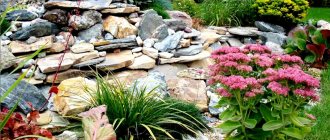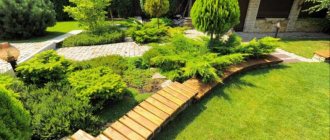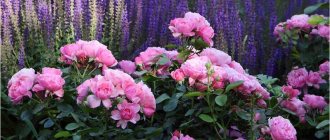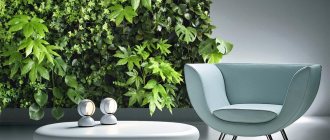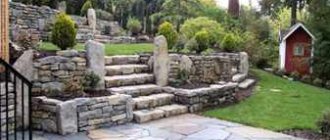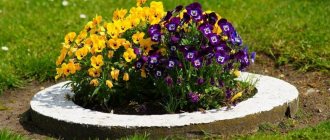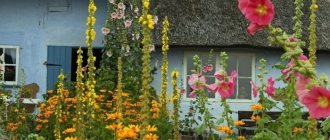Functionality of vertical gardening
The purpose and functions of a vertical landscaping structure depend on where it will be placed and what type of structure will be used.
Climbing plants placed along the vertical wall of any building will add originality to the facade and will also help hide any defects. This type of landscaping composition is in great demand in places with hot climates. This is explained by the fact that a cascade of greenery on top of the façade prevents the surface from overheating, creating a pleasant shadow.
Photos of vertical gardening clearly demonstrate that this method is excellent for zoning the territory of a site.
The simplest way, which does not require special knowledge in landscape art, is to delimit the recreation area from outbuildings using a hedge. This is also an excellent option to hide your plot of land from prying eyes.
If you plant many climbing species of plants on the territory, you can easily adjust the microclimate in a small area.
A pergola or gazebo decorated with beautiful vegetation will protect the owners from the sultry heat and maintain humidity in the air. Also, vertical landscaping structures will help protect against dust and noise.
A vertical flower bed, placed on a separate plot, will transform the appearance of the entire local area, while saving square meters of land.
Green watering systems
The modular stand must be mounted in such a way that it is convenient to use. For irrigation, manual and automatic methods are used, which is carried out using a special pump immersed in a tank with fertilizers.
The liquid, rising upward under pressure, is evenly distributed along the hose located horizontally on the top shelf. Watering of plants is carried out through holes in the hose and is regulated by a sensor.
In some cases, a self-irrigation system is used. Used for small walls. It is necessary to control the moisture so as not to overdo it.
Arched structures
Arches are often used to create a harmonious transition between different functional areas. And you can complete the composition with a beautiful object in the form of a statue or an unusually shaped plant that will greet guests at the end of the vault.
Varieties of climbing roses, unusual clematis, and honeysuckle are suitable plants for vertical gardening of arched compositions. The material for making arches is often metal or wood; structures made from stone elements are less common.
It is important to correctly calculate the size of the building so that bindweed plants do not interfere with passage under the arch. The height of the structure is chosen to be at least 2.2 meters, the width is in the range from 120 cm to 150 cm.
DIY felt modules
From felt, you can make a structure that is not inferior in efficiency to purchased modules. Only in this case, watering will have to be done manually, and a film for waterproofing should be attached under the felt structure.
Make a frame from boards and PVC panels. You will need slats or plastic pipes to hold the frame together. According to the size of the finished frame, distribute the material into the fold taking into account the depth of the pockets, fasten with pins and sew on a sewing machine across the folds.
Place plants wrapped in rags with moss into the resulting pockets. Install a long narrow tray under the homemade module to collect liquid after watering.
Living boundary wall
Hedges, which are often used for vertical landscaping, can be presented in the form of lattice panels, trellises or posts, which are connected by chains.
Most structures are made of wood, less often of a metal alloy painted in a wood tone or olive shade. The vertical lattice fabric is in harmony with the arches, and placed between the openings of the pergola, it will be an excellent tool for zoning.
A column of pillars, which are fastened together with chains or rope, which is planted with climbing roses or clematis, will be a wonderful decorative transition from one area in the country to another.
What are vertical beds, and what materials can they be built from?
In the classical concept, a garden bed is a horizontal structure. But when the land allotment is limited, there is no place to plant a garden, but you really want to grow fresh vegetables or plant flowers, the vertical comes to the rescue! This is how vertical beds were once invented, because upward space is unlimited, just like our imagination. So let's look at what you can use to make vertical beds with your own hands.
From plastic bottles
Nothing could be easier! You just need to cut off a small part of the bottle in the longitudinal direction (no more than 1/3), screw the neck with a lid. So a kind of flower pot is ready.
Now they need to be fixed vertically. There are several ways to do this. For example, using a simple structure of supports, which can be either wooden or metal, and rope, wire or fishing line, which I will attach our flower pots to each other. Or you can attach the bottles in any order to a fence, house wall or some other structure.
Then we fill the bottles with soil and the vertical bed is ready! All that remains is to plant the plants. This is where one point becomes important - the correct selection of plants depending on the size of the bottle. If the bottles were initially small and narrow (volume up to 1.5 liters), then it is advisable to plant low-growing species. These are various greens (lettuce, parsley, basil), low-growing and unpretentious annual plants (petunia, lobelia, snapdragon, etc.). Larger bottles allow larger plants to be planted.
From a plastic or metal pipe
This material makes excellent vertical beds for strawberries. In principle, growing strawberries vertically is very advisable. This way the berry gets more light for ripening, it is easier to pick and it gets less dirty with soil. The design itself looks more complicated than the previous version.
We will need two pipes - one of small diameter, the second of larger diameter. The smaller one will be inserted inside a wide pipe and serve for drip irrigation. We make pinholes in a narrow pipe and wrap the pipe with burlap so that in the future the holes will not become clogged with earth. The lower end of the pipe must be closed, for example, with tape, so that the water does not go into the ground.
In a wide pipe we make holes approximately 5 cm in diameter (depending on the diameter of the pipe). We arrange them in a checkerboard pattern, usually in three rows, and take into account that one side of the pipe will be attached to a vertical surface (wall, fence). There is no need to make holes below 10 cm in both pipes. The lower end of the wide pipe must also be plugged.
Then we insert the narrow pipe into the wide one and begin filling it with soil. First, we fill drainage (expanded clay, gravel) up to the first holes, and then - ready-made soil, pre-mixed with hydrogel (retains moisture) and finely crushed foam (prevents the soil from compacting, thereby providing oxygen access to the roots). All that remains is to plant strawberry seedlings in the holes, whose roots should preferably be dipped in clay and manure mash beforehand, and fill the inner pipe with water.
Pipes can also be connected into a kind of frame to form a pyramid. Such a structure will be mobile and can be moved to a shelter for the winter, thereby preserving the roots of plants from destructive frosts.
The pipe can also be placed horizontally, hanging or attaching to a wall/fence, one above the other.
Moreover, in this case, pipes must be selected with a diameter of at least 10 cm and cut in half lengthwise. This option is good for growing a variety of greens.
Made from wood and pallets
Pallets are good because their volumetric design with sparsely packed boards allows you to build an original vertical bed. You will also need spunbond and primer. First, the wood should be treated with a protective compound. Then we tightly cover one side of the pallet with spunbond, lay the material down and carefully begin to tightly fill the pallet with soil, while simultaneously moistening it. Ready!
Now you can plant plants in the holes between the boards and install the resulting bed vertically, for example, against a wall. And not only in the country, but even on the balcony such a structure will look beautiful and original.
Wood is an excellent material for constructing various structures for plants, so show your imagination and create your own unique version of a vertical vegetable garden or garden yourself.
As an example, we’ll give you some great ideas for buildings in the form of a pyramid, trellis, rack with shelves, and so on.
From car tires
This option is suitable for creating a flower bed, since tires are not the best material for growing berries and edible herbs due to its low environmental friendliness. And for a flowerbed - just right!
We install tires of different diameters on top of each other, starting with the largest. As a result, we get a kind of pyramid. Moreover, it is necessary to fill the tires with soil in stages. First fill the bottom one, then install a smaller diameter tire on it, fill it with soil and install the next one. And the last stage is planting. Just keep in mind that it will be inconvenient to water a very tall structure.
The top of such a flower bed can be crowned with a small sculpture or decorative flowerpot. Tires can also be placed in a checkerboard pattern, forming a small wall.
Made from metal mesh
In this design you can grow not only flowers, berries and herbs, but also potatoes. For the last option, roll the mesh into a cylinder and secure it. The diameter is approximately 90-100 cm. The inner walls need to be lined with straw, and the resulting structure should be filled with compost, not all at once, but gradually.
We lay the first tubers at a height of 50 cm from the ground, after watering the first layer. Then we cover it again with a layer of 50 cm of compost, spill it and lay the tubers again. The height of such a bed is at your discretion.
Instead of straw, you can use spunbond or film. Then flowers, strawberries, and greens are planted in such a structure.
From burlap
We sew a bag, which we fill with soil and hang on a wall or fence. You can make small horizontal cuts in the bag, where you can plant the seedlings. The downside is frequent watering, because burlap allows air to pass through very well.
The examples given are only a small part of what a vertical bed can be. All you have to do is imagine a little and you will succeed!
Hanging products
One of the new and no less attractive trends in landscaping is decorating the interior with hanging models. Thus, you can decorate an outdoor terrace with hanging flowerpots with petunias, begonias and other hanging plant species.
The wall planes of buildings or a fence can be decorated with phytomodules for vertical gardening, in which plants that do not require abundant watering are planted.
For DIY landscaping, you can use available materials. So, by sawing a plastic pipe, connecting several similar parts together and hanging the composition, we get an unusual element of vertical landscaping decoration in which it is possible to grow fragrant herbs and spices. In such products, holes must be made at the bottom so that excess moisture can escape.
Planting trees on the siteKerria or Keria: photo and description of the shrub, rules and subtleties of growing a plant with yellow flowers
Ornamental shrubs in landscape design blooming in autumn
Hanging models can be used for landscaping in an apartment. This will save space without giving up a luxurious green corner at home.
Choosing the right plants
The choice of plants, which should preferably be selected in groups, depends on where the green wall will be located.
Plants are light-loving and shade-tolerant, loving moisture and not tolerating waterlogging. To make the plants feel comfortable and the wall to look luxurious, it is necessary to study the characteristics of the plants.
Flower shops offer a huge selection of flowering and green pets: with long and short leaves, ampelous and erect, unpretentious and capricious to care for.
If the flower tag is marked “mini”, then this plant is suitable for this planting method.
Vertical flower beds
Vertical flower beds are not used so often by ordinary people, although this method is not only visually attractive and original, but also saves usable space.
Such structures are created from garden containers of different sizes, placing the largest one at the bottom, and smaller models going higher. It is enough to arrange 3-4 tiers to make caring for such a flower bed convenient.
Plants suitable for planting in vertical structures include brightly colored petunias, marigolds and low-growing asters, fern species and spicy spices.
Growing greens at home
Pots of thyme, mint, rosemary, sage and other herbs can be placed on a section of the wall near the kitchen work area.
This solution will be a good help for the housewife and an excellent original design style. Herbs can be grown year-round by sowing seeds periodically.
Annuals or perennials?
Plants involved in the design of green walls can live for only a year or become a full-fledged decoration for quite a long period of time.
Annuals will allow you not to worry too much about timely feeding and crown formation. They help change the decor of the site every year. But such plants will require additional investments in the purchase of seeds and time for germination and care of young seedlings.
Perennials occupy the same place, so they do not need to create special conditions for quick and high-quality rooting. You can not pay much attention to them during the hot planting season, postponing most care procedures to a later period.
However, such plants will not make it possible to change the surrounding landscape from year to year. Although, with a strong desire, annuals can diversify the usual plantings, shading the foliage of their older brothers with their bright colors. A minor drawback will be that caring for the perennial inhabitants of the garden will be a little more difficult.
Perennial plants are mainly used to decorate the walls of apartments or private houses.

